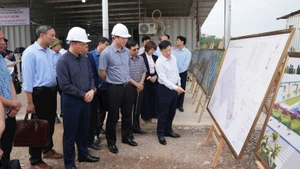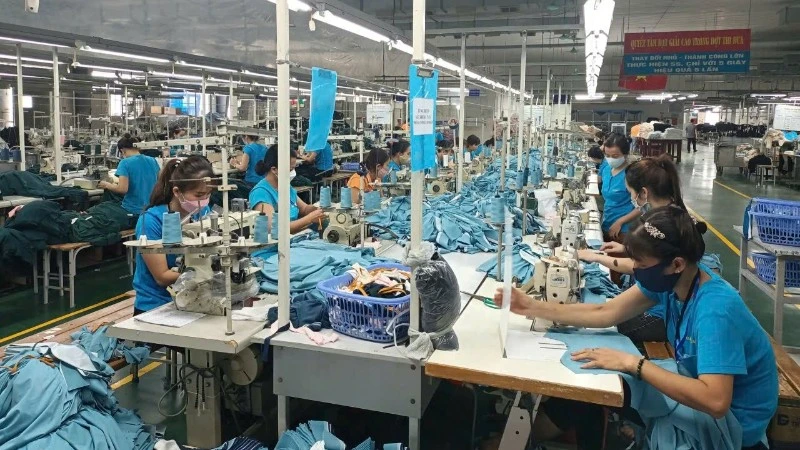Prime Minister Pham Minh Chinh has required ministries and localities throughout the country to use all possible measures to fuel domestic production and business activities, which will help increase the country’s economic growth, which remained far lower than expected.
“Economic growth must be the No.1 priority now. We have to expand both aggregate supply and demand of the economy through pushing up three key drivers of growth, including investment, export, and consumption,” PM Chinh noted.
The State Bank of Vietnam has been ordered to continue carrying out the effective, timely, flexible, and proactive monetary policy, via the continued decrease of lending rates, restructuring of debts, and a rise in money supply in a proper manner.”
Slowdown
According to the World Bank’s latest economic update entitled “Making Public Investment Work for Growth” released last week, a challenging external environment and weaker domestic demand are leading to a slowdown in economic growth in Vietnam. But the economy will pick up pace over the second half of this year, and in the following years.
The report shows that Vietnam’s economic growth slowed from 8% in 2022 to 3.72% in the first half of 2023. It forecasts a moderate growth of 4.7% in 2023, gradually accelerating to 5.5% in 2024 and 6.0% in 2025. A proactive fiscal policy supporting short-term demand, removing barriers to the implementation of public investment, and addressing infrastructure constraints, can help the economy achieve these targets and promote long-term growth.
“Vietnam’s economy is being tested by internal and external factors. To boost economic growth, the government can support aggregate demand through effective public investments, thereby creating jobs, and stimulating economic activity,” said Carolyn Turk, World Bank country director for Vietnam. “Beyond short-term support measures, the government should not lose sight of structural institutional reforms – including in the energy and banking sectors – as they are imperative for long-term growth”.
Two weeks ago, Fitch Solutions revised Vietnam’s economic prospects this year.
“We expect Vietnam’s real GDP growth to slow sharply from 8.0% in 2022 to 5.8% in 2023,” Fitch Solutions.
According to the Asian Development Bank’s (ADB) Asian Development Outlook July 2023 released last month, the general economic growth of Southeast Asia is lowered by the bank to 4.6% this year and 4.9% next year, compared with April estimates of 4.7% and 5.0%, respectively.
The ADB also revised its growth forecast for Vietnam down from 6.5 to 5.8% in 2023, and from 6.8% to 6.2% in 2024.
Prompted by economic difficulties, the International Monetary Fund has also reduced its 2023 prediction for Vietnam’s growth from 6.2% in January to 4.7% last month. This year’s rate will however also be among the highest in the Emerging and Developing Asia group, with 30 economies forecasted.
PM Chinh also stressed, “In August and the remaining months of this year, the situation will be much more difficult. Thus we must continue to keep a close eye on the realities with an increase required for the quality of forecast activities and policy response. We must make careful preparations for all possible scenarios so that we will not be passive in any situation. All policies must be flexible in implementation.”
Strengthening drivers
From now until the year’s end, the government will focus on improving exports, consumption, and investment, which remains weak now, despite some signals for recovery.
In July, total export turnover is estimated to hit 29.68 billion USD, up 0.8% over the previous month. July is also the month with the second-largest export turnover since early this year, only lower than the 29.7 billion USD recorded in March.
In the first seven months of this year, Vietnam’s total goods export and import turnover is estimated to be 374.23 billion USD – down 13.9% year-on-year “due to colossal difficulties in the global market”, according to the MoIT.
This includes 194.73 billion USD worth of exports – down 10.6%, and 179.5 billion USD for imports – down 17.1%. The total trade surplus reached 15.23 billion USD, which is more than 11 times higher than that of 1.34 billion USD, in the corresponding period last year.
Earlier the MoIT set a target of 775 billion USD in total goods export-import revenue this year – up by 6% from 2022. This includes 394 billion USD for exports and 381 billion USD for imports, with a trade surplus of 13 billion USD.
The Ministry of Planning and Investment (MPI) has warned of big risks in the global markets, which can affect the Vietnamese economy, mostly exports.
“The domestic economy is quite open to the global economy, with the country’s total export-import turnover nearly double its GDP. Thus it is prone to be vulnerable to external shocks,” said an MPI report sent to the government.
Vietnam’s GDP reached 409 billion USD last year, when its total goods export-import turnover was 1.79 times higher, standing at 732 billion USD.
Meanwhile, the total seven-month retail and consumption revenue in the country reached more than 150.8 billion USD, up 10.4% as compared to the same period last year.
Also, the goods retail revenue in the first seven months of 2023 is estimated to be as much as 117.2 billion USD, accounting for nearly 79% of the total and up 9% year-on-year, in which the price of many important groups of items also expanded, such as food and foodstuff (12.9%), cultural and educational items (over 10%), garments (8.8%), home appliances (3.6%), and travelling means (except for automobiles) up 1.7%.
According to Vietnam’s Ministry of Planning and Investment (MPI), public investment will be the key driver for economic recovery and growth in 2023. A considerable amount of public investment is scheduled to be disbursed in 2023. The government is committed to disbursing 30 billion USD in the year, of which almost all capital has been allocated to disbursing ministries and provinces so far.
The government last week reported that in the first seven months of this year, the total disbursement of public investment nationwide is estimated to be 11.3 billion USD – up 34.5% year-on-year, meaning a great deal of capital has been inserted into the economy.
“Along with the continued implementation of the stimulus programme endorsed in January 2022, this spending [public investment] will generate substantial multiplier effects, creating a strong motivation for the whole economy,” the ADB said.
The MPI is now continuing to update economic growth scenarios in line with new developments in international and domestic economic situations.
The economy grew 3.32% year-on-year in the first quarter of the year before bouncing back to 4.14% year-on-year in the second quarter, leading to a six-month growth rate of 3.72% year-on-year.
A month ago, the MPI reported to the government two economic growth scenarios for the last six months of 2023 and the whole year, based on such a low growth rate for the first half of 2023 –also the lowest six-month growth rate in the 2011-2023 period.
Under the first scenario, the economy is expected to climb 6% this year, with 6.8% for the third quarter and 9% for the fourth quarter, which are 0.3% and 1.9% respectively, higher than the initial plan set early this year. The rate must be 8% in the second half of the year.
Under the second scenario, the entire-year growth rate is projected to be 6.5%, with 7.4% for the third quarter and 10.3% for the fourth quarter, which are 0.9 and 3.2% respectively, higher than the initial plan set early this year. The rate must be 8.9% in the second half of the year.
“However, it would be very hard to materialise such targets because the economy grew 13.71 and 5.92% in the third and fourth quarters of last year, which were very high. However, we will have to make our best efforts to materialise the set target despite the massive difficulties ahead. We must take advantage of all opportunities and policies, and overcome woes to accomplish the growth goal,” said MPI Minister Nguyen Chi Dung.
















